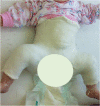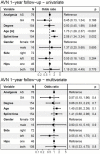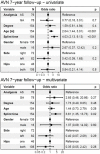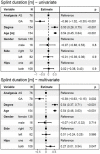Splint Duration and Not the Mode of Anesthesia Is the Main Factor Influencing Avascular Necrosis After Closed Reduction for Developmental Dysplasia of the Hip in Kosovo
- PMID: 35558375
- PMCID: PMC9090470
- DOI: 10.3389/fped.2022.850605
Splint Duration and Not the Mode of Anesthesia Is the Main Factor Influencing Avascular Necrosis After Closed Reduction for Developmental Dysplasia of the Hip in Kosovo
Abstract
The aim of this study was to determine whether the use of analgesia and sedation (AS) as opposed to general anesthesia (GA) for closed reduction and spica casting of children with severe developmental dysplasia of the hip (DDH) influenced the long-term incidence of avascular necrosis (AVN). In a prospective, randomized, single-blinded clinical trial we investigated 100 pediatric patients with DDH type IIIa, IIIb, and IV (according to Graf classification), who were randomly assigned into the group receiving AS, and the group receiving GA. Baseline demographics, splint duration, and type of DDH were carefully assessed. The presence of AVN was assessed at the follow-up visits at 1 and 7 years after the end of treatment. The AS-group consisted of 50 patients (46 girls) with 76 hips affected (n = 11/Type-IIIa, n = 32/Type-IIIb, and n = 33/Type-IV). The GA-group consisted also of 50 patients (44 girls) with 78 hips involved (n = 15/Type-IIIa, n = 34/Type-IIIb, and n = 29/Type-IV). At 7-years follow-up, AVN was diagnosed in 9 of 154 hips (5.8%), 5 hips in the AS-group and 4 hips in the GA group. The logistic regression model showed no significant difference in AVN incidence between the AS and GA groups at 7-years follow-up (p = 0.27). The multivariate regression analysis showed that neither the type of DDH nor the age at diagnosis influenced the incidence of AVN (p = 0.48 and p = 0.28, respectively). Splint duration was identified as the only significant factor for the long-term incidence of AVN in the treatment of severe DDH. For every month of longer splint duration, the odds of AVN at 7-years follow-up increased by a factor of 3.81 (95%CI: 1.35-13.73, p = 0.02). Closed reduction and spica casting of children with severe DDH under AS can be considered a feasible alternative to management under GA. All efforts must be made to diagnose patients with DDH as early as possible and shorten the duration of splint treatment to prevent the development of AVN. Level of Evidence. Level II-1.
Keywords: analgesia and sedation; closed reduction; developmental dyspalsia of the hip; general anesthesia; splint duration.
Copyright © 2022 Sllamniku, Beqo, Krasniqi, Tërshana, Murtezani, Quehenberger and Haxhija.
Conflict of interest statement
The authors declare that the research was conducted in the absence of any commercial or financial relationships that could be construed as a potential conflict of interest.
Figures






Similar articles
-
Does Perfusion MRI After Closed Reduction of Developmental Dysplasia of the Hip Reduce the Incidence of Avascular Necrosis?Clin Orthop Relat Res. 2016 May;474(5):1153-65. doi: 10.1007/s11999-015-4387-6. Clin Orthop Relat Res. 2016. PMID: 26092677 Free PMC article.
-
Correlation between avascular necrosis and the presence of the ossific nucleus when treating developmental dysplasia of the hip.J Child Orthop. 2013 Dec;7(6):501-5. doi: 10.1007/s11832-013-0538-z. Epub 2013 Oct 22. J Child Orthop. 2013. PMID: 24432113 Free PMC article.
-
Risk factors for avascular necrosis after closed reduction for developmental dysplasia of the hip.J Child Orthop. 2016 Jun;10(3):185-92. doi: 10.1007/s11832-016-0743-7. Epub 2016 May 13. J Child Orthop. 2016. PMID: 27177477 Free PMC article.
-
Cochrane Review: Screening programmes for developmental dysplasia of the hip in newborn infants.Evid Based Child Health. 2013 Jan;8(1):11-54. doi: 10.1002/ebch.1891. Evid Based Child Health. 2013. PMID: 23878122 Review.
-
Comparison of outcomes of different Graf grades of developmental dysplasia of the hip in infants treated with Tubingen splint versus Pavlik harness - A systematic review.J Orthop. 2023 Nov 27;49:68-74. doi: 10.1016/j.jor.2023.11.060. eCollection 2024 Mar. J Orthop. 2023. PMID: 38075458 Free PMC article. Review.
Cited by
-
Comparative long-term outcomes of Petit-Morel versus overhead traction methods versus immediate closed reduction for late-detected developmental dysplasia of the hip: A systematic review.J Child Orthop. 2024 Nov 8;18(6):590-599. doi: 10.1177/18632521241265603. eCollection 2024 Dec. J Child Orthop. 2024. PMID: 39559720 Free PMC article. Review.
References
-
- ASK. Statistikat-Afatshkurtra-te-Sherbimeve. Kosovo: Kosovo-Agency-of-Statistics; (2021).
LinkOut - more resources
Full Text Sources
Research Materials

